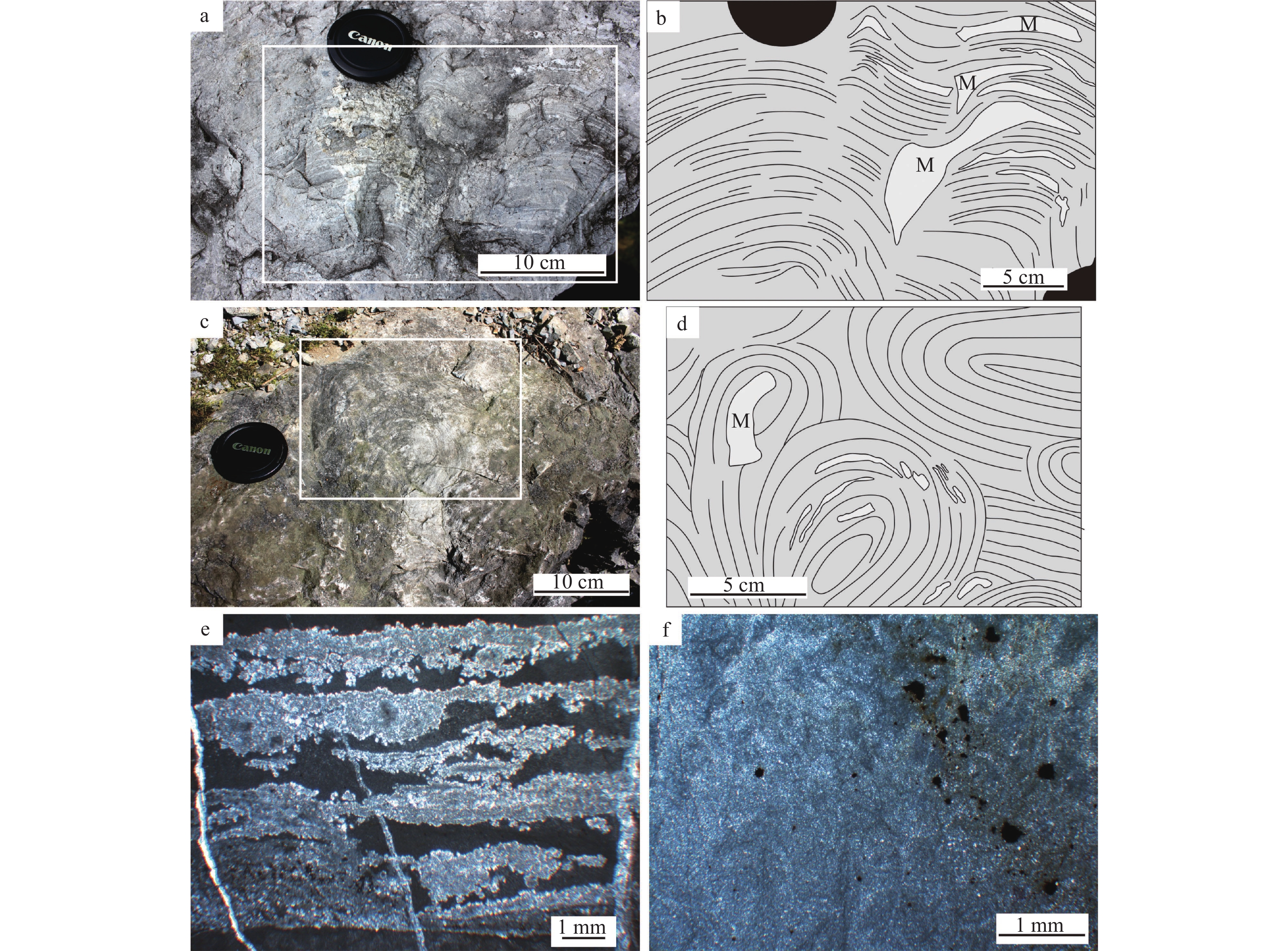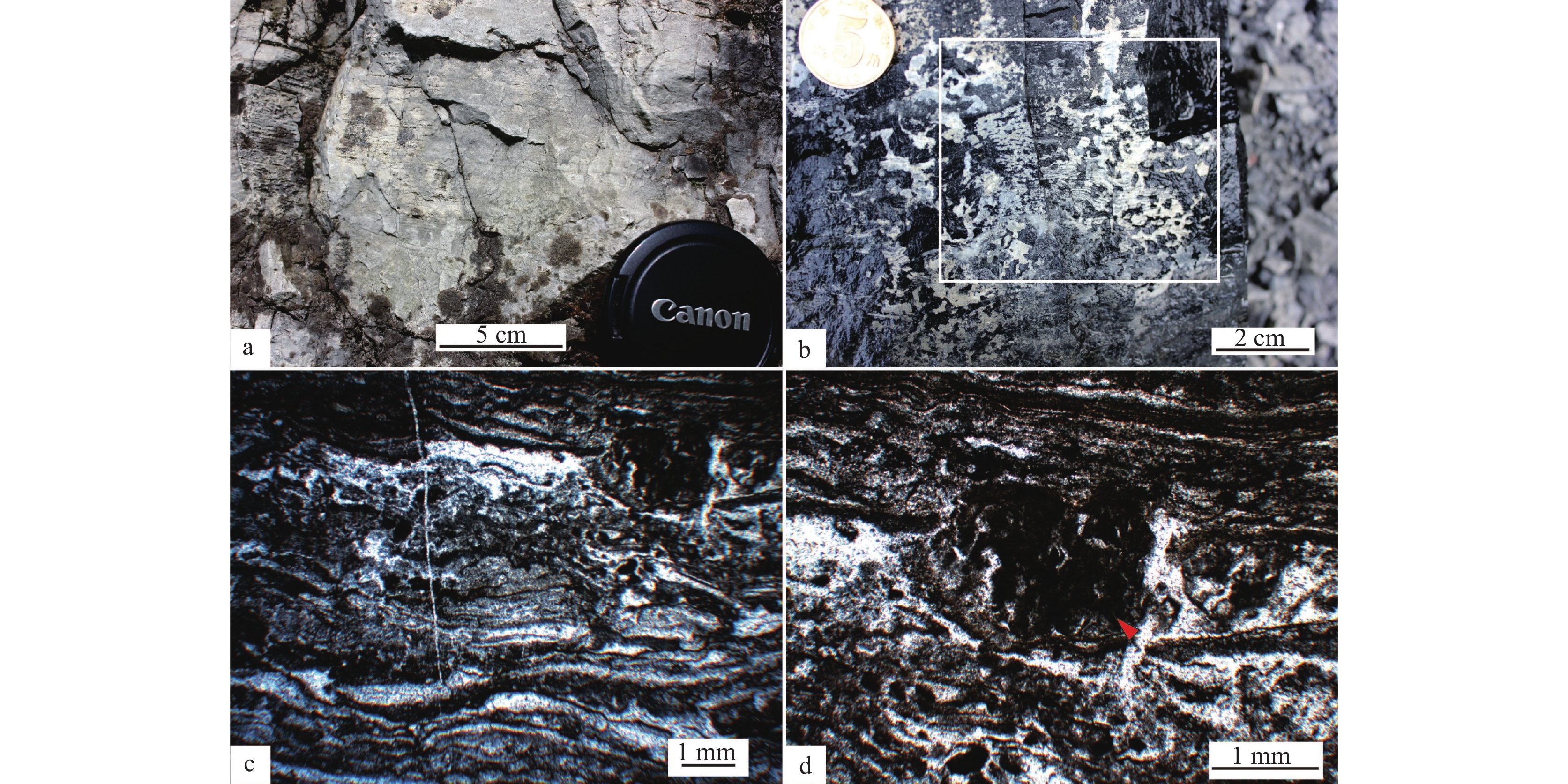Stromatolites of the Ediacaran Dengying Formation in Hefeng, western Hubei Province and its ecological environment discussion
-
摘要:
研究目的 扬子区鄂中台地埃迪卡拉系灯影组赋存丰富的叠层石,但尚未有报道对其进行系统描述。通过识别台地西南端鹤峰白果坪剖面灯影组中的叠层石种类、分析沉积环境,阐述古环境对叠层石形态分布的控制,为后续开展鄂中台地埃迪卡拉纪的叠层石研究提供参考。
研究方法 通过剖面测量和镜下观察,于白果坪灯影组白云岩中识别出平直纹层、Stratifera层状、微波状纹层三种层状叠层石和一种Baicalia柱状叠层石。
研究结果 研究认为上述的叠层石类型分别对应周期性暴露(前两种类型)、潟湖(微波状)和潮间带—潮下带上部(柱状)的生态位。对比与白果坪剖面灯影组同期叠层石的形态及分布规律,可知形成叠层石的微生物群落强烈受控于古水深等环境条件。层状叠层石生态区间宽,柱状及其他形态叠层石仅见于局限地区,多样性较低。
结论 扬子区碳酸盐岩台地长期稳定的大范围潮坪环境造成的广泛分布浅水生态位和局限分布较深水生态位,是导致灯影组沉积期叠层石多样性低的主要原因。
Abstract:This paper is the result of geological survey engineering.
Objective The Ediacaran Dengying Formation in the Central−Hubei Platform of the Yangtze region hosts abundant stromatolites, yet there is a lack of systematic reports on them. This study aims to address this gap by identifying stromatolite types in the Dengying Formation at the Baiguoping section in the southwestern part of the platform. Through this, we analyze the sedimentary environment, aiming to elucidate the influence of the ancient environment on stromatolite distribution. The insights gained serve as a valuable reference for future research on Ediacaran stromatolites in the Central−Hubei Platform.
Methods Utilizing section surveys and microscopic observations, this study identifies stratiform and columnar stromatolites in the dolostones of the Ediacaran Dengying Formation at the Baiguoping section. Stratiform stromatolites include flat−laminated, Stratifera, and wavy−laminated forms, columnar stromatolite see the Baicalia form genus.
Results In the southwestern Central−Hubei Platform, these stromatolites are associated with various environments: Periodic exposure settings for the flat−laminated and Stratifera forms, lagoon environments for the wavy−laminated form and intertidal to upper subtidal zones for the columnar stromatolites. Published data reveals that during the deposition period of the Ediacaran Dengying Formation, stratiform stromatolites were abundant on the Yangtze Platform, meanwhile columnar and other stromatolite forms were rare, indicating limited morphological diversity.
Conclusions The scarcity of stromatolite variations can be attributed to widespread shallow water niches and locally deeper water niches resulting from long−term stable tidal flat environments in the Yangtze Platform.
-

-
[1] Awramik S M. 1984. Ancient stromatolites and microbial mats[C]//Cohen Y, Castenholz R W, Halvorson H O (eds.). Microbial Mats: Stromatolites. New York: Alan R. Liss Inc., 150 Fifth Avenue, 1–22.
[2] Cao Ruij, Yu Congliu. 1991. Late Sinia microstromatolites first discovered from Shimen, Hunan[J]. Acta Micropalaeontologica Sinica, 8(4): 365−371 (in Chinese with English abstract).
[3] Cao Ruiji, Yuan Xunlai. 2006. Stromatolites[M]. Hefei: University of Science and Technology of China Press, 1–383(in Chinese).
[4] Cao Ruiji, Zhao Wenjie. 1978. The algal flora of the Tongying Formation (Upper Sinian System) in southwestern China[J]. Collection Papers of Nanjing Institute of Geology and Palaeonotology, CAS, 10: 1−-40 (in Chinese).
[5] Chen Huineng, Zhu Shixing, Luo Qiling. 1996. The formation of high–grade phosphorite related to ancient algae in Jing–Xiang area, Hubei Province[J]. Scientia Geologica Sinica, 31(2): 176−185 (in Chinese with English abstract).
[6] Chen Menge. 1991. Sinian fossils in China[C]//Liu Hongyun (ed.). Sinian in China. Beijing: Science Press, 334–361(in Chinese).
[7] Duda J P, Zhu M, Reitner J. 2016. Depositional dynamics of a bituminous carbonate facies in a tectonically induced intra–platform basin: The Shibantan Member (Dengying Formation, Ediacaran Period)[J]. Carbonates Evaporites, 31: 87−99. doi: 10.1007/s13146-015-0243-8
[8] Jiang G, Shi X, Zhang S, Wang Y, Xiao S. 2011. Stratigraphy and paleogeography of the Ediacaran Doushantuo Formation (ca. 635–551 Ma) in South China[J]. Gondwana Research, 19: 831−845. doi: 10.1016/j.gr.2011.01.006
[9] Kennedy M. 2013. The nonlinear effects of evolutionary innovation biospheric feedbacks on qualitative environmental change: From the microbial to metazoan world[J]. American Naturalist, 181: S100−S111. doi: 10.1086/670023
[10] Kuang Hongwei, Fan Zhengxiu, Liu Yongqing, Peng Nan, Zhu Zhicai, Yang Zhenrui, Wang Zhixian, Yu Huiliang, Zhong Quan. 2019. Stromatolite characteristics of Mesoproterozoic Shennongjia Group in the northern margin of Yangtze Block, China[J]. China Geology, 2(3): 364‒381.
[11] Li Anpeng, Gao Da, Hu Mingyi, Zhao Yuru, Zhu Chuanyong, Dai Yichen. 2023. Deposition model and main factors controlling depositional processes for microbialites in the Fourth Member, Dengying Formation, Central Sichuan Basin[J]. Acta Sedimentologica Sinica, 41(4): 1080–1096 (in Chinese with English abstract).
[12] Li F, Deng J, Kershaw S, Burne R, Gong Q, Tang H, Lu C, Qu H, Zheng B, Luo S, Jin Z, Tan X. 2021. Microbialite development through the Ediacaran−Cambrian transition in China: Distribution, characteristics, and paleoceanographic implications[J]. Global and Planetary Change, 205: 103586.
[13] Liu Shugen, Song Jinmin, Luo Ping, Qing Hairuo, Lin Tong, Sun Wei, Li Zhiwu, Wang Hao, Pen Hanlin, Yu Yongqiang, Long Yi, Wang Yuanbo. 2016. Characteristics of microbial carbonate reservoir and its hydrocarbon exploring outlook in the Sichuan Basin, China[J]. Journal of Chengdu University of Technology (Science & Technology Edition), 43(2): 129−152 (in Chinese with English abstract).
[14] Luo Yao, Tan Xiucheng, Zhao Dongfang, Luo Wenjun, Liu Yun, Xiao Di, Qiao Zhanfeng, Zeng Wei. 2023. Sedimentary characteristics of the Ediacaran microbial carbonates and their geological implications: a case study of the Member 4 of Dengying Formation from Wellblock MX8 in central Sichuan Basin[J]. Journal of Palaeogeography, 24(2): 278–291 (in Chinese with English abstract).
[15] Ma Yongsheng, Chen Hongde, Wang Guoli. 2009. Tectonic–Sequence Lithofacies Paleogeographic Atlas in South China[M]. Beijing: Science Press, 1–301(in Chinese).
[16] Meyer M, Xiao S, Gill B C, Schiffbauer J D, Chen Z, Zhou C, Yuan X. 2014. Interactions between Ediacaran animals and microbial mats: Insights from Lamonte trevallis, a new trace fossil from the Dengying Formation of South China[J]. Palaeogeography, Palaeoclimatology, Palaeoecology, 396: 62–74.
[17] Peters S E, Husson J M, Wilcots J. 2017. The rise and fall of stromatolites in shallow marine environments[J]. Geology, 45(6): 487−490. doi: 10.1130/G38931.1
[18] Qiao Dan, Shi Guo, Ren Yue, Zhang Zhaoyang, Tao Jing. 2019. Stromatolite characteristics and sedimentary environment analysis of Sinian Dengying Formation in JIangshan area of Zhejiang, China[J]. Journal of Earth Sciences and Environment, 41(6): 734−747 (in Chinese with English abstract).
[19] Song Jinmin, Liu Shugen, Li Zhiwu, Luo Ping, Yang Di, Sun Wei, Pen Hanlin, Yu Yongqiang. 2017. Characteristics and controlling factors of microbial carbonate reservoirs in the Upper Sinian Dengying Formation in the Sichuan Basin, China[J]. Oil & Gas Geology, 38(4): 741−752 (in Chinese with English abstract).
[20] Tang Feng, Gao Linzhi, Wang Ziqiang. 2009. Palaeogeography and palaeoecology of the Ediacaran (Sinian) macrofossil biota in South China[J]. Journal of Palaeogeography, 11(5): 524−533 (in Chinese with English abstract).
[21] Tang Feng, Yin Chongyu, Liu Pengju, Duan Delin, Gao Linzhi. 2008. Morphological comparison of the Ediacaran Miaohe Biota from South China: Implications for their affinities and ecology[J]. Acta Geologica Sinica, 82(5): 601−611 (in Chinese with English abstract).
[22] Walter M R. 1976. Stromatolites, Developments in Sedimentology, 20[M]. Amsterdam: Elsevier, 1–790.
[23] Wang Wenzhi, Yang Yueming, Wen Long, Luo Bing, Luo Wenjun, Xia Maolong, Sun Sainan. 2016. A study of sedimentary characteristics of microbial carbonate: A case study of the Sinian Dengying Formation in Gaomo area, Sichuan basin[J]. Geology in China, 43(1): 306−318 (in Chinese with English abstract).
[24] Wang X, Erdtmann B D, Chen X, Mao X. 1998. Integrated sequence–, bio– and chemostratigraphy of the terminal Proterozoic to Lowermost Cambrian “black rock series” from central South China[J]. Episodes, 21(3): 178−189. doi: 10.18814/epiiugs/1998/v21i3/007
[25] Xiao S, Laflamme M. 2009. On the eve of animal radiation: Phylogeny, ecology and evolution of the Ediacara biota[J]. Trends in Ecology & Evolution, 24(1): 31−40.
[26] Yuan Xunlai, Wan Bin, Guan Chengguo, Chen Zhe, Zhou Chuanming, Xiao Shuhai, Wang Wei, Pang Ke, Tang Qing, Hua Hong. 2016. The Lantian Biota[M]. Shanghai: Shanghai Scientific & Technical Publishing House, 1–138 (in Chinese).
[27] Zhang Wei, Yang Ruidong, Ren Haili, Gao Junbo, Mao Tie. 2015. Sedimentary characteristics of phosphorite deposits in the Sinian Dengying Formation of Weng’an County, Guizhou Province[J]. Geology and Exploration, 51(2): 238−245 (in Chinese with English abstract).
[28] Zhang Yun, Copper P. 1993. Formation and Evolution of the Early Earth Biosphere[M]. Memory Essays for Professor Le Senxun. Beijing: Geological Publishing House, 161–180(in Chinese).
[29] Zhao Dongxu. 1992. Epiphyton manganese stromatolites of Doushantuo Formation, Chengkou, Sichuan[J]. Chinese Science Bulletin, 20: 1873−1875 (in Chinese).
[30] Zhou C, Xiao S. 2007. Ediacaran δ13C chemostratigraphy of South China[J]. Chemical Geology, 237: 89−108. doi: 10.1016/j.chemgeo.2006.06.021
[31] Zhou Y, Li Z. 2023. Terminal Ediacaran microbialite lithofacies associations with paleoenvironmental constraints in a high−frequency sequence stratigraphic framework of Sichuan Basin, SW China[J]. Frontiers in Earth Science, 11: 1085313.
[32] Zhu M, Zhang J, Steiner M, Yang A, Li G, Erdtmann B D. 2003. Sinian–Cambrian stratigraphic framework for shallow–to deep–water environments of the Yangtze Platform: An integrated approach[J]. Progress in Natural Science, 13(12): 951−960. doi: 10.1080/10020070312331344710
[33] Zhu M, Zhang J, Yang A. 2007. Integrated Ediacaran (Sinian) chronostratigraphy of South China[J]. Palaeogeography, Palaeoclimatology, Palaeoecology, 254: 7–61.
[34] 曹瑞骥, 俞从流. 1991. 湖南石门晩震旦世微叠层石的发现[J]. 微体古生物学报, 8(4): 365−371.
[35] 曹瑞骥, 袁训来. 2006. 叠层石[M]. 合肥: 中国科学技术大学出版社, 1–383.
[36] 曹瑞骥, 赵文杰. 1978. 西南地区晚震旦世灯影组藻类植物群[J]. 中国科学院南京地质古生物研究所集刊, 10: 1−40.
[37] 陈辉能, 朱世兴, 罗其玲. 1996. 荆襄磷矿优质磷块岩的形成与藻类的关系[J]. 地质科学, 31(2): 176−185.
[38] 陈孟莪. 1991. 中国震旦系的古生物[M]//刘鸿允主编. 中国震旦系. 北京: 科学出版社, 334–361.
[39] 李安鹏, 高达, 胡明毅, 赵玉茹, 朱传勇, 戴逸晨. 2023. 川中地区灯影组四段微生物岩沉积模式及主控因素[J]. 沉积学报, 41(4): 1080–1096.
[40] 刘树根, 宋金民, 罗平, Qing Hairuo, 林彤, 孙玮, 李智武, 王浩, 彭瀚霖, 余永强, 龙翼, 万元博. 2016. 四川盆地深层微生物碳酸盐岩储层特征及其油气勘探前景[J]. 成都理工大学(自然科学版), 43(2): 129−152.
[41] 罗垚, 谭秀成, 赵东方, 罗文军, 刘耘, 肖笛, 乔占峰, 曾伟. 2022. 埃迪卡拉系微生物碳酸盐岩沉积特征及其地质意义:以川中磨溪 8 井区灯影组四段为例[J]. 古地理学报, 24(2): 278–291.
[42] 马永生, 陈洪德, 王国力. 2009. 中国南方构造–层序岩相古地理图集(震旦纪–新近纪)[M]. 北京: 科学出版社, 1–301.
[43] 乔丹, 时国, 任玥, 张兆阳, 陶菁. 2019. 浙江江山地区震旦系灯影组叠层石特征及沉积环境分析[J]. 地球科学与环境学报, 41(6): 734−747.
[44] 宋金民, 刘树根, 李智武, 罗平, 杨迪, 孙玮, 彭瀚霖, 余永强. 2017. 四川盆地上震旦统灯影组微生物碳酸盐岩储层特征与主控因素[J]. 石油与天然气地质, 38(4): 741−752.
[45] 唐烽, 高林志, 王自强. 2009. 华南伊迪卡拉纪宏体生物群的古地理分布及意义[J]. 古地理学报, 11(5): 524−533.
[46] 唐烽, 尹崇玉, 刘鹏举, 段德麟, 高林志. 2008. 华南伊迪卡拉纪“庙河生物群”的属性分析[J]. 地质学报, 82(5): 601−611.
[47] 王文之, 杨跃明, 文龙, 罗冰, 罗文军, 夏茂龙, 孙赛男. 2016. 微生物碳酸盐岩沉积特征研究—以四川盆地高磨地区灯影组为例[J]. 中国地质, 43(1): 306−318.
[48] 袁训来, 万斌, 关成国, 陈哲, 周传明, 肖书海, 王伟, 庞科, 唐卿, 华洪. 2016. 蓝田生物群[M]. 上海: 上海科学技术出版社, 1–138.
[49] 张伟, 杨瑞东, 任海利, 高军波, 毛铁. 2015. 贵州瓮安震旦系灯影组磷矿沉积特征[J]. 地质与勘探, 51(2): 238−245.
[50] 张昀, Copper P. 1993. 地球早期生物圈的形成与进化[M]. 纪念乐森浔教授论文集. 北京: 地质出版社, 161–180.
[51] 赵东旭. 1992. 四川城口陡山沱组的Epiphyton锰质叠层石[J]. 科学通报, 20: 1873−1875.
-




 下载:
下载:



